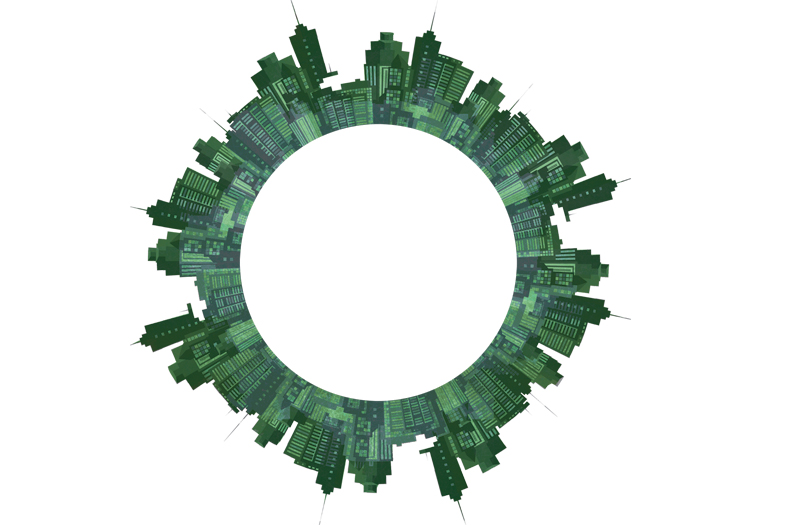Sustainability: A goal rather than a ‘perfect’ solution

India’s construction sector is assessed at approximately $100 billion industry . As a result of government spending, private investments as well as foreign direct investment, India has made a place for itself into the top ten spending nations on construction globally. A recent report on “Global Construction 2020”, assessed that India will be the third largest global construction market after China and USA. As the construction sector accelerates in achieving the desired goals, there also arises a need for sustainable development approach as to not pose threat to the fast depleting natural resources reserves in conquest of meeting rising infrastructure needs and key hurdles of overcoming the challenge of infrastructure bottlenecks. So what does sustainability actually means?
According to Ar. Naresh V Narasimhan, Head, Venkataramanan Associates, “Sustainability is one of the world’s most talked about, but least understood word. Its meaning is often clouded by differing interpretations. But, the basic aim of sustainability is to meet the present day needs for infrastructure without compromising on the ability of the future generations to meet their needs.”
Understanding varied layers and interpretations of sustainability with reference to its applicability, sustainability in simple terms is a way of carrying out activities without depleting resources or having harmful impacts on the environment and associated elements.
In terms of sustainability in construction sector, the focus lies on building structures with energy efficient or green materials that reduces the impact on the environment, thus adopting eco-friendly and green development, which now has become a vital need of the hour.
Today, we are talking about sustainable development, which has become the buzzword in the industry as it joins the bandwagon of ‘go green’ approach.
The ‘Go Green’ approach has led to evolution of several different concepts like building green buildings, smart buildings and sustainable buildings translating into buzzwords for the industry to go with. This has constituted the entire idea of sustainability as approach for Indian construction sector.
Building sustainable structures
In the recent times, with advent of progressive trend of sustainability approach adopted by the Indian construction sector, there has been a much stress on building sustainable structures. In simple terms, sustainable structure is a product of a design philosophy which focuses on increasing the efficiency of resource use. Sustainable building design involves saving energy, using space efficiently and reducing waste over the lifecycle of a building
As per Ar. Er. S.P. Anchuri, Chief Consultant, Anchuri & Anchuri, “Sustainable construction is associated solely with energy efficiency. If one looks at what is being built globally and being commended as laudable, admirable, and to be emulated, one finds a large number of iconic buildings – with all sorts of striking forms and exotic materials, which are then promoted as forms of sustainable construction merely because they have some photo-voltaic panels stuck to the roof, some holes dug into the ground to obtain cooling water or tempered air, or some wind turbines stuck to the roof, to generate renewable energy.”
Space efficiency has become a key component in sustainable building design. Today, architects make every effort to make the most of interior day-lighting through the introduction of daylight and views into occupied areas of a building. This requires an open floor plan to avoid blocking areas off from exterior windows. The use of a raised-floor system can also improve space efficiency by supporting more efficient under floor systems and reducing overall building height. Two areas to focus on are power and data delivery systems and raised floor solutions.
Amit Gupta, Founding Partners, Studio Symbiosis says “An understanding of the site, topography, materials, design brief, structure and services is essential to create sustainable architecture. It is the integration of all these elements that result in complete sustainable architecture.”
Bringing sustainability in to Indian construction industry
Defining sustainability in buildings is a complex concept. The term ‘green building’ is identical with ‘high-performance building’, ‘sustainable design and construction’ as well as other terms that refer to a holistic approach to design and construction. A Green building is designed, constructed and operated to minimise the total environmental impacts while enhancing user comfort and productivity. The drive towards more sustainable construction is achievable only when all the stakeholders in the industry, including developers, designers, builders and suppliers recognise and appreciate its importance.
There is a need for all parties to make a conscious decision to adopt the use of sustainable materials in their building projects. An analysis is required for each stage of construction in order to achieve sustainability as the end product in form of energy-efficient structure has become need of the hour.
As per the Indian Green Building Council, over 2,400 green building projects in the country have already been constructed or are being constructed in India. This brings the industry to take a note of importance of green certification, validating the structures build with focus on sustainability using energy-efficient materials.
Ar. Prem Nath, Premnath and Associates say that, “It takes an Intention’ to build sustainable. Most of the projects, today, aspire to be Green, only to achieve Green Rating Certificates, while there are developers which achieve ‘Green’ and are then awarded green ratings & special citations. Once there is an intention, it takes right decisions at the planning stage itself wherein one instils basic principles of architecture such as shading, orientation, etc. followed by comprehensive specification of all green features and materials, which ensures the development evolves to be sustainable from its ‘grass-root’ level itself.”
As sustainable construction involves prefabricated products, it would be helpful to bring in significant suppliers and specialists early in the design stage. Implementation down the entire construction value chain is also important. There is a need for sharing of knowledge and expertise in design and the use of such materials. Equally, critical is the building of capabilities and skills in construction and installation. The performance of such buildings in safety and quality should remain high.
Ar. Er. S.P. Anchuri, Chief Consultant, Anchuri & Anchuri say, “Reducing waste during construction or over a building’s lifecycle directly minimizes the negative environmental impact of a building. Any product that is reusable and reconfigurable contributes to waste reduction because less material is required to upgrade or reconfigure to contain future changes. It is also important that building products match the lifecycle of a building to avoid frequent replacement.”
Role of technology and solutions in making sustainable structures
With green building becoming an essential part of today’s world, more and more new construction technologies are being developed to keep up with this rising shift to sustainability. Sustainability can be realised by delivering innovative solutions and new ways of working.
Sustainable construction technologies are constantly being developed for wide-scale and more affordable distribution, a testimony to the fact is increasing demand for green buildings that uphold the optimistic outlook for the future of sustainable, green buildings.
According to the World Economic Forum, “Wherever the new technologies have properly permeated the construction industry, the outlook is an almost 20 per cent reduction in total life cycle costs of a project, as well as substantial improvements in completion time, quality and safety.”
Technological innovations in building construction and management boost safety and are imperative to increase efficiencies, better automation, curb costs and minimise construction timelines. These improve margins for developers and ensure lower prices for customers as well provide increasingly safer homes.
Ripu Daman Sharma, Country Manager Sales, India Subcontinent, Lutron Electronics says, “Innovations come in various hues to improve the products and practices of the construction industry. They can be useful to implement green building norms, which are increasingly important to reduce the carbon footprints of various structures during construction itself. This is achieved by using energy-efficient technologies, alternative building materials and innovative construction techniques. Since such smart buildings entail lower energy and maintenance costs, within a few years the savings recoup the initial investments.”
New building materials, 3D printing, prefabrication, and modular approaches are among the emerging trends shaking up the construction industry and boosting growth for those who are ready to adopt, particularly in India where the take up has been slow to date.
Paul Wallett, Regional Director, Trimble Solutions, India and Middle East says, “Finally, technology is leading to a transformation of the construction industry. Experts already predict that the Internet of Things (IOT) will transform the construction industry by 2025 through automation, software, prefabrication, and 3D printing. Indian contractors and construction industry players should adopt construction technology aggressively over the next few years in order to prepare for the future of construction, using innovations such as Field BIM (on mobile devices), cloud-based collaboration tools and mixed reality tools.”
Green buildings are designed to improve the overall impact of the built environment on human health and the natural environment. Lighting helps to create a healthier workplace. In fact, international standards such as LEED and BREEAM recognise the importance of lighting to personal welfare.
Currently, around 15 per cent of global electricity demand is for lighting and a global transition to LED and connected lighting technologies, where LED lights are connected and controlled wirelessly via cloud-based software systems, will reduce electricity consumed by lighting to 8 per cent by 2030, thereby contributing towards creating a sustainable planet
Sumit Joshi Vice Chairman and Managing Director, Philips Lighting India says, “Technology is a key enabler in making cities, buildings and public infrastructure more sustainable in the long term. Lighting is an integral part of any building or city’s infrastructure and hence can play an important role in creating sustainable structures. With the introduction of energy efficient LED’s, the power consumption of lighting has been significantly reduced as compared to conventional lighting.”
Technology is constantly evolving and rapidly changing the landscape of many different industries. However, the construction industry has been slow to integrate this change into their business models. At the same time, early adopters understand the benefits of embracing new technological advancements as they look to gain an edge over their competition.
Shrinivas Chebbi VP, India & SAARC, Eco Buildings & Partner Projects Schneider Electric says, “A big trend in the construction industry today is retrofitting outdated buildings with more advanced structures. Retrofitting involves adjusting or replacing old infrastructure in existing buildings with new technology to improve performance. This could include numerous internal upgrades such as replacing lighting systems, installing internal climate sensors and outfitting the building with a state-of-the-art building automation system.”
With Government’s stress on schemes like ‘Housing for All by 2022’, Atal Mission for Rejuvenation and Urban Transformation (AMRUT) will bring in increased activity in infrastructure and related sectors. This also opens doors of opportunities for employing the progressive global trend of sustainability by the Indian construction sector, thus building sustainable and using available natural resources effectively. The use of sustainable material will add to cost-efficiency and help in reducing construction cost for the developers. With technological advancements assisting in achieving the sustainability feat, it is important to take cognisance of how sustainability takes over the Indian construction sector in order to provide to sustainable development as ‘perfect solution’ or as ‘long-term goal’.
Cookie Consent
We use cookies to personalize your experience. By continuing to visit this website you agree to our Terms & Conditions, Privacy Policy and Cookie Policy.









